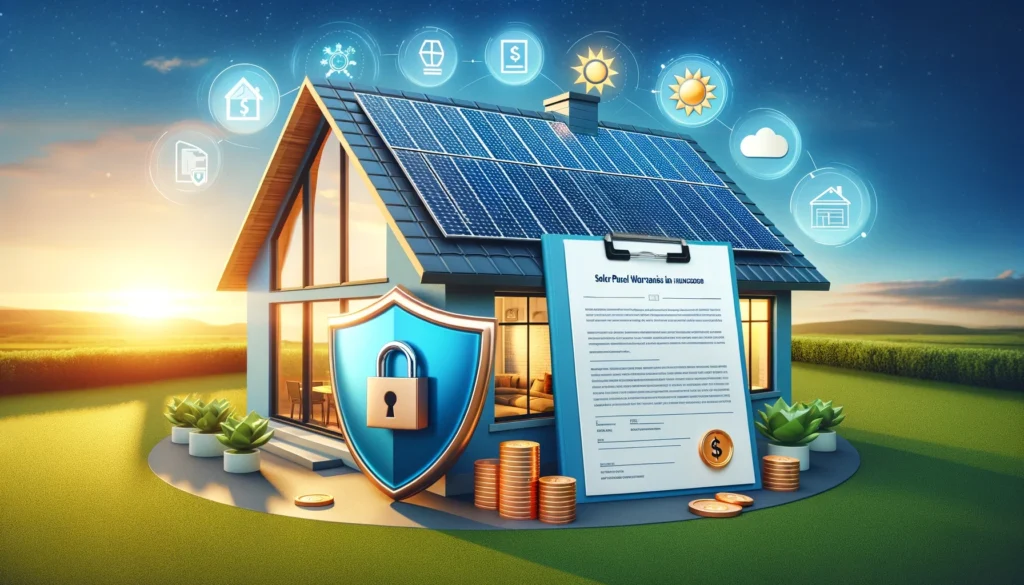Solar Panel Warranties & Insurance: Protecting Your Investment for the Long Haul
Investing in solar panels is a big decision, and homeowners want to ensure their systems remain protected for years to come. While solar panels are designed for durability and long-term performance, having a clear understanding of warranties and insurance options provides peace of mind and financial security.
In this guide, we’ll break down how solar panel warranties work, what they typically cover, and whether additional insurance is necessary to safeguard your investment.
- Understanding Solar Panel Warranties
Solar panel warranties are designed to protect your system against unexpected issues, ensuring you get the most out of your investment. There are typically two main types of warranties provided by manufacturers and installers:
Performance Warranty
- Guarantees a minimum power output for a specific number of years (typically 25 to 30 years).
- Covers degradation of efficiency over time (most panels retain around 80-90% of their original output after 25 years).
- Ensures that your panels will continue producing a reliable amount of electricity throughout their lifespan.
Product (Equipment) Warranty
- Covers defects in materials or workmanship, usually ranging from 10 to 25 years.
- Protects against issues such as faulty wiring, cracked glass, or panel malfunctions.
- If a panel fails due to a manufacturing defect, the manufacturer typically replaces or repairs it at no cost.
These warranties give homeowners confidence that their solar panels will perform as expected for decades.
- Additional Component Warranties
Solar panels aren’t the only parts of your system that come with warranties—other key components also have protection plans:
- Inverter Warranty: Covers issues related to the device that converts solar power (DC) into usable electricity (AC). Typically lasts 10 to 15 years, with some premium models offering 20-25 years.
- Battery Storage Warranty: If your system includes battery storage, the warranty typically lasts 5 to 15 years, depending on the manufacturer and battery chemistry.
- Racking & Mounting Warranty: Protects the structural integrity of the racking system that holds your panels in place. Usually covered for 10 to 20 years.
Checking the warranties for each component ensures that your entire system is fully protected.
- What Do Solar Warranties Cover (and What They Don’t)?
While solar warranties provide extensive protection, it’s important to understand their limitations.
What’s Typically Covered:
✔ Defective materials or workmanship (e.g., cracked panels, faulty wiring).
✔ Significant loss of energy production beyond the expected degradation rate.
✔ Failure due to normal weather conditions (e.g., rain, snow, wind).
What’s Typically NOT Covered:
✘ Damage caused by extreme weather events (hailstorms, hurricanes, tornadoes, earthquakes).
✘ Accidental or intentional damage (e.g., tree branches falling, improper handling).
✘ Issues caused by poor installation (this would fall under the installer’s workmanship warranty).
Understanding these distinctions helps homeowners know when they can file a claim under warranty and when they may need insurance.
- Does Homeowners Insurance Cover Solar Panels?
Many homeowners assume their existing homeowners insurance policy will automatically cover their solar panels. While this is often true, there are a few key considerations:
- Roof-Mounted Solar Panels: In most cases, solar panels installed on your roof are considered a permanent part of your home and are covered under your standard homeowners insurance policy.
- Ground-Mounted Systems: If your solar panels are installed separately from your home (e.g., on the ground or a carport), they may require additional coverage.
- Coverage Limits: Some policies may have limits on how much they will pay for solar panel damage, so checking with your insurance provider is essential.
- Weather-Related Protection: Homeowners insurance typically covers damage caused by storms, hail, or fire, but it’s crucial to confirm with your provider.
Since solar panels increase the value of your home, you may need to adjust your policy to ensure full coverage.
- Should You Get Additional Solar Insurance?
If your homeowners insurance doesn’t provide full coverage or you live in an area prone to extreme weather, additional insurance may be worth considering.
Options for Extra Protection:
- Solar Panel-Specific Insurance: Some companies offer dedicated solar insurance policies that cover both physical damage and lost energy production.
- Extended Warranty Plans: Some manufacturers and solar installers offer extended warranty options that provide coverage beyond the standard terms.
- Performance Insurance: Covers lost income if your system underperforms due to defects or damage.
While additional insurance comes with added costs, it can be a smart investment for homeowners who want extra peace of mind.
- What About Workmanship Warranties?
In addition to manufacturer warranties, your solar installer should provide a workmanship warranty that covers installation-related issues.
- Coverage Period: Typically lasts between 5 to 10 years.
- What’s Included: Protects against faulty installation, electrical wiring issues, and roof damage caused during panel placement.
- Why It Matters: Even high-quality solar panels won’t perform properly if they’re not installed correctly. Choosing a reputable installer with a strong workmanship warranty ensures your system functions as expected.
Be sure to ask your installer about their warranty policies before signing a contract.
- How to Make a Warranty or Insurance Claim
If you experience an issue with your solar panels, follow these steps to file a claim:
For Warranty Claims:
- Check your warranty documents to confirm the issue is covered.
- Contact the manufacturer or installer and provide details of the problem.
- Schedule an inspection (if required) to assess the issue.
- Repair or replacement will be arranged by the manufacturer if your claim is approved.
For Insurance Claims:
- Document the damage with photos and details of the event that caused it.
- Contact your homeowners insurance provider to review your policy coverage.
- File a claim and provide any necessary supporting documents.
- Insurance adjusters may inspect the damage before approving coverage.
Having clear documentation and an understanding of your coverage can make the claims process smoother.
Conclusion: Protecting Your Solar Investment for the Long Term
Solar panels are a long-term investment, and understanding warranties and insurance ensures you’re protected from unexpected costs. By knowing what your warranty covers, ensuring your homeowners insurance includes solar panels, and considering additional coverage options, you can enjoy worry-free solar energy for decades.
At Shyne Solar we help homeowners navigate every aspect of solar installation, including warranty guidance and insurance considerations. Contact us today to learn how we can protect your solar investment and provide a seamless transition to renewable energy!
Ready to make the switch?
Contact us today to learn how solar panels can help you save more in the long run!
Complete Residential Solar Panels and Systems. Serving Texas, Oklahoma, Kansas, Missouri, Utah, Florida & Ohio
Get a Free Quote Now
